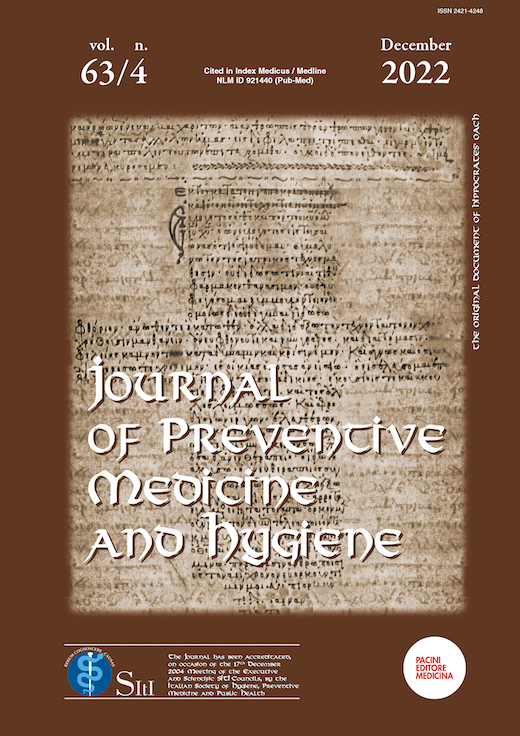Abstract
Abstract:
Introduction – With the recent Covid-19 pandemic, the terms quarantine, contagion and infection have again become part of our everyday speech, prompting historians to reflect on the settings in which they were originally used and to make comparisons with the present time. How did people cope with epidemics in the past? What measures were taken?
Objectives - We analyse the institutional response of the Republic of Genoa to a calamity that shook the city – the plague of 1656-1657. In doing so, we focus particularly on the public health measures implemented, as recorded also in unpublished and archival documents.
Discussion - In order to tighten control over the population, Genoa was divided into 20 zones, each of which was placed under the authority of a Commissioner endowed with criminal jurisdiction.
The Commissioners' duties concerned the spheres of public health, public order and those tasks which today we would assign to "civil protection". Through the official documentation and the trial records kept by the Chancellor of one of these zones, we can shed light on the Commissioners' everyday activities and assess the impact of the public health measures on the population.
Conclusions - The 17th century plague in Genoa provides us with an important testimony of a well-organised and structured public health policy – an institutional response involving the adoption of efficacious measures of safety and prevention in the field of hygiene and public health. From the historical-social, normative and public health perspectives, this meaningful experience highlights the organisation of a large port city, which was at the time a flourishing commercial and financial hub.
References
[1] Antero da San Bonaventura P. Li lazaretti della città e riviere di Genova del MDCLVII [...] descritti dal R. P. Antero Maria da S. Bonaventura scalzo agostiniano, Genova, Pietro Giovanni Calenzani e Francesco Meschini, 1658, ristampa anastatica: Genova 1974.
[2] Maurizio da Tolone, Trattato politico da praticarsi ne’ tempi di peste circa gl’ordini communi e particolari dell’infermarie, purgationi e quarantene, Genova, Pietro e Giovanni Calenzani 1661.
[3] Biblioteca Medica Mario Segale, Compendio de' decreti de Ser.mi Colleggi et Ill.mo Mag.to di Sanità con insertione di leggi de Consegli della Ser.ma Rep.ca per preservare, e liberare la città e dominio dalla peste negl'anni 1656 e 1657 raccolti da Gio. Bartolomeo Campasso, 1669.
[4] Anatra B, La peste del 1647-1658 nel Mediterraneo occidentale: il versante italiano, in Popolazione, società e ambiente. Temi di demografia storica italiana (secc. XVII-XIX), Bologna, Clueb, 1990, p.549.
[5] Topi L, Forme di controllo in una città “appestata”: Roma 1656-1657, «Eurostudium», 2017, pp. 25-26.
[6] Assereto G. Per la comune salvezza dal morbo contagioso, cit., pp. 15-20.
[7] ASge, Senato Senarega, n. 114, 27 July 1656.
[8] Presotto D, Genova 1656-1657. Cronache di una pestilenza, in «Atti della Società ligure di Storia patria», n.s., V (LXXIX), 1965, fasc. II, p. 320-329.
[9] ASge, Sanità, n. 1881, 13 sept 1656.
[10] Campasso, cc. 61v-67v, Istruzioni dei commissari di quartiere.
[11] Campasso, cc. 68r-75r, Istruzioni dei capostrada.
[12] Campasso, cc. 32v.
[13] Pullan B, Plague and perceptions of the poor in early modern Italy in J. L. STEVENS CRAWSHAW (a cura di), Plague Hospitals. Public Health for the City in Early Modern Venice, Farnham, Ashgate Publishing Company, 2012, pp. 101-123
[14] Presotto D, Genova 1656-1657. Cronache di una pestilenza, in «Atti della Società ligure di Storia patria», n.s., V (LXXIX), 1965, fasc. II, p. 385.
[15] ASge, Manoscritti, n. 265.
[16] ASG, Notai giudiziari, n. 2080, 1 sept 1656.
[17] ASG, Notai giudiziari, n. 2080, 1 nov 1656.
[18] ASG, Notai giudiziari, n. 2080, 3 oct 1656.
[19] ASge, Ufficio di Sanità, n. 1891, 11 may 1657.
[20] ASGe, Senato Senarega, n. 1092.
[21] Orsini D, Martini M. From inoculation to vaccination: the fight against smallpox in Siena in the 18th and 19th centuries. Infez Med 2020;4:634e41.
[22] Martini M, Brigo F, Rasori G. Vaccination in the 19th century in Italy and the role of the catholic church in public health: a historical overview. J Prev Med Hyg 2022;63:E104e8. https://doi.org/10.15167/2421-4248/jpmh2022.63.1.2518.
[23] Bifulco M, Di Zazzo E, Pisanti S, Martini M, Orsini D. The nineteenth-century experience of the kingdom of the two Sicilies on mandatory vaccination: an Italian phenomenon?. May 6 Vaccine 2022. https://doi.org/10.1016/j.vac- cine.2022.04.052. S0264-410X(22)00492-3.
[24] Martini M, Bifulco M, Orsini M. Smallpox vaccination and vaccine hesitancy in the Kingdom of the Two Sicilies (1801) and the great modernity of Ferdinand IV of Bourbon: a glimpse of the past in the era of the SARS-COV-2 (COVID- 19) pandemic. Public Health 213 (2022) 47e53.
[ https://doi.org/10.1016/j.puhe.2022.09.012]

